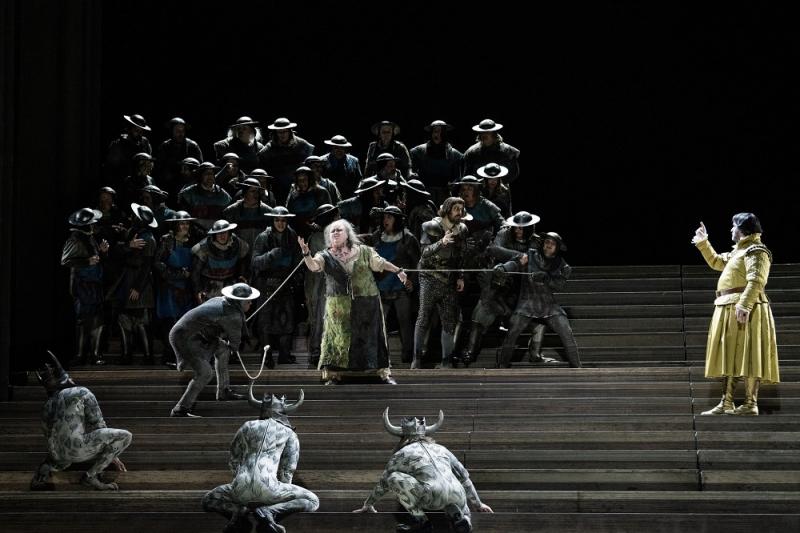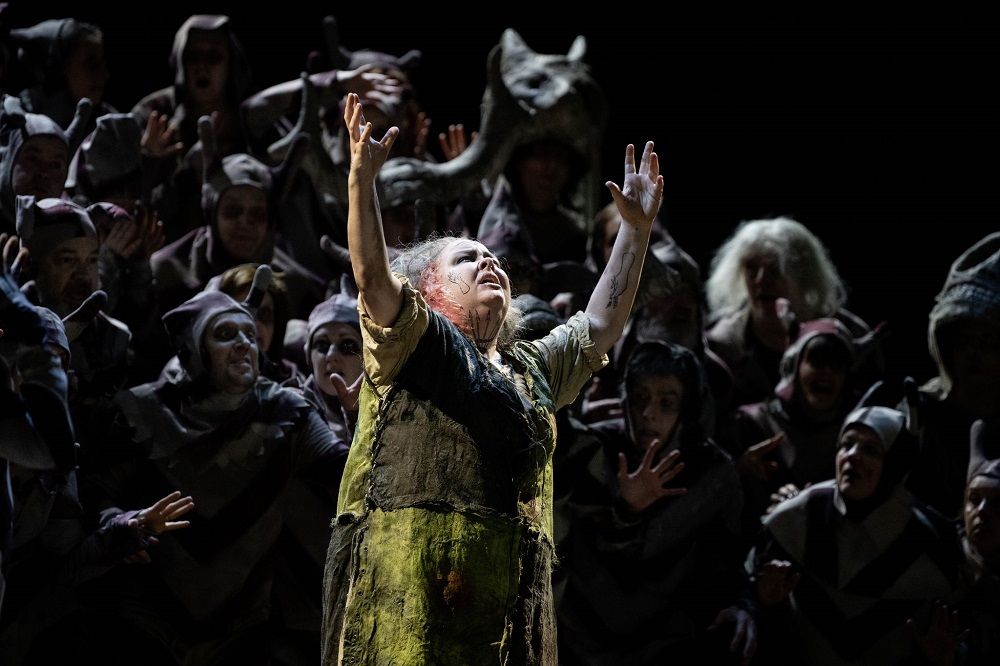Il trovatore, Royal Opera review - heaven and hell | reviews, news & interviews
Il trovatore, Royal Opera review - heaven and hell
Il trovatore, Royal Opera review - heaven and hell
Everyone delivers, but one day Verdi's hit-and-miss melodrama will get the right staging

The trouble with Trovatore, Verdi’s sometimes barrel-organish, slightly middle-aged troubadour, isn’t so much the silly shocker of a plot, triggered by a gypsy so crazed with vengeance that she throws her own baby on a bonfire by mistake, as the choppy dramatic line, so hard to thread. Under the circumstance, Adele Thomas’s medieval-hell production could have been a lot worse, and the vocal quality is there throughout under Antonio Pappano’s watchful guidance.
Two of the cast are officially new to the run, though soprano Rachel Willis-Sørensen had already replaced Marina Rebeka in some performances (I don’t know if Rebeka was also struck by the Covid that forced star attraction Jamie Barton to withdraw temporarily, though I’m happy to say Barton was back last night).  What an insanely taxing role the “angel” Leonora is, and yet Willis-Sørensen (pictured above by Olivia Kahler - images for second cast are due in July) has everything it takes: an opulent lower register (essential for the “Miserere” especially), agility in the runs, an ability to open up to peak top notes in the many arching phrases, and effortless breath control that allowed her to take as one phrase what’s normally broken into two at the start of the first aria, “Tacea la notte placida”. She could probably be asked to act convincingly more than she does, too. Thomas doesn’t avoid what she says she wants to in her programme interview: “four people standing still in front of a chorus".
What an insanely taxing role the “angel” Leonora is, and yet Willis-Sørensen (pictured above by Olivia Kahler - images for second cast are due in July) has everything it takes: an opulent lower register (essential for the “Miserere” especially), agility in the runs, an ability to open up to peak top notes in the many arching phrases, and effortless breath control that allowed her to take as one phrase what’s normally broken into two at the start of the first aria, “Tacea la notte placida”. She could probably be asked to act convincingly more than she does, too. Thomas doesn’t avoid what she says she wants to in her programme interview: “four people standing still in front of a chorus".
Actually the fifth, Roberto Tagliavini as what appears to be a devil-master Ferrando surrounded by bouncing demons, moves about quite a bit in the opening narrative (pictured below). But the others actually aren’t asked to move that much; more often a Spamalot-ish chorus wanders and waggles and waves around them (at least it’s choreographed, a notch up on Katharina Thomas’s messy Un ballo in maschera here, and Annemarie Woods has fun - perhaps too much fun - with the costumes).  Leonora has some byplay with companion Ines but usually either stands still or sits on various steps of the staircase a la Kosky Carmen which supposedly gives the impression of movement. Willis-Sørensen certainly needs to muster and focus vocal forces in the massive scene strewn with tortured bodies and dismembered limbs in front the prison where lover Manrico is held – and she does, magnificently. Ludovic Tézier as the rat Count di Luna seems hampered by a heavy dress, and simply delivers – very well, in the case of “Il balen”, but there’s no character as such. Gregory Kunde has stepped into the cast, complete with medieval mullet, to find his way around as best he can, but there’s no real charge between the main couple. This Manrico is not quite Italianate, and not thrustingly youthful, but Kunde does have real silvery-steel cut, even if the top C in “Di quella pira” is so obviously prepared for (and adequate, when it comes).
Leonora has some byplay with companion Ines but usually either stands still or sits on various steps of the staircase a la Kosky Carmen which supposedly gives the impression of movement. Willis-Sørensen certainly needs to muster and focus vocal forces in the massive scene strewn with tortured bodies and dismembered limbs in front the prison where lover Manrico is held – and she does, magnificently. Ludovic Tézier as the rat Count di Luna seems hampered by a heavy dress, and simply delivers – very well, in the case of “Il balen”, but there’s no character as such. Gregory Kunde has stepped into the cast, complete with medieval mullet, to find his way around as best he can, but there’s no real charge between the main couple. This Manrico is not quite Italianate, and not thrustingly youthful, but Kunde does have real silvery-steel cut, even if the top C in “Di quella pira” is so obviously prepared for (and adequate, when it comes).
You can’t hold a good Azucena down, though, and Barton (pictured below) goes for every opportunity. Apart from the very climactic phrases, where she’s covered by the orchestra (at least from where I was sitting), she does it all, like Willis-Sorensen: going one better on the cutting chest voice (as any Azucena must), lunging for top emphasis and spitting out the gypsy’s vengeful fury. The essential soft singing when the imprisoned and to-be-burned mother is soothed by her putative son, in “Ai nostril monti”, truly delivers, the finishing touch beautifully etched in by Pappano’s hallucinatory sleep-phantom violins.  It’s good to be rid here of the demons and semaphoring chorus, though they come back at the end big-time. Next time, less might be more: I’ll never forget my first experience of Trovatore at Covent Garden, the Visconti production with the scene-shifters on strike, so we got handsome costumes against a black background - which, with splashes of red is probably all you need (I have to add that an indisposed Leonora, Martina Arroyo, was replaced by Rita Hunter singing in English – memorably, to Carlo Bergonzi’s Manrico, with “what are you saying? I cannot understand you”). This is a case of stirred but not shaken. Perhaps it’s time simply to do Trovatore in concert and leave it at that.
It’s good to be rid here of the demons and semaphoring chorus, though they come back at the end big-time. Next time, less might be more: I’ll never forget my first experience of Trovatore at Covent Garden, the Visconti production with the scene-shifters on strike, so we got handsome costumes against a black background - which, with splashes of red is probably all you need (I have to add that an indisposed Leonora, Martina Arroyo, was replaced by Rita Hunter singing in English – memorably, to Carlo Bergonzi’s Manrico, with “what are you saying? I cannot understand you”). This is a case of stirred but not shaken. Perhaps it’s time simply to do Trovatore in concert and leave it at that.
rating
Explore topics
Share this article
The future of Arts Journalism
You can stop theartsdesk.com closing!
We urgently need financing to survive. Our fundraising drive has thus far raised £49,000 but we need to reach £100,000 or we will be forced to close. Please contribute here: https://gofund.me/c3f6033d
And if you can forward this information to anyone who might assist, we’d be grateful.

Subscribe to theartsdesk.com
Thank you for continuing to read our work on theartsdesk.com. For unlimited access to every article in its entirety, including our archive of more than 15,000 pieces, we're asking for £5 per month or £40 per year. We feel it's a very good deal, and hope you do too.
To take a subscription now simply click here.
And if you're looking for that extra gift for a friend or family member, why not treat them to a theartsdesk.com gift subscription?
more Opera
 Tosca, Welsh National Opera review - a great company reduced to brilliance
The old warhorse made special by the basics
Tosca, Welsh National Opera review - a great company reduced to brilliance
The old warhorse made special by the basics
 BBC Proms: The Marriage of Figaro, Glyndebourne Festival review - merriment and menace
Strong Proms transfer for a robust and affecting show
BBC Proms: The Marriage of Figaro, Glyndebourne Festival review - merriment and menace
Strong Proms transfer for a robust and affecting show
 BBC Proms: Suor Angelica, LSO, Pappano review - earthly passion, heavenly grief
A Sister to remember blesses Puccini's convent tragedy
BBC Proms: Suor Angelica, LSO, Pappano review - earthly passion, heavenly grief
A Sister to remember blesses Puccini's convent tragedy
 Orpheus and Eurydice, Opera Queensland/SCO, Edinburgh International Festival 2025 review - dazzling, but distracting
Eye-popping acrobatics don’t always assist in Gluck’s quest for operatic truth
Orpheus and Eurydice, Opera Queensland/SCO, Edinburgh International Festival 2025 review - dazzling, but distracting
Eye-popping acrobatics don’t always assist in Gluck’s quest for operatic truth
 MARS, Irish National Opera review - silly space oddity with fun stretches
Cast, orchestra and production give Jennifer Walshe’s bold collage their all
MARS, Irish National Opera review - silly space oddity with fun stretches
Cast, orchestra and production give Jennifer Walshe’s bold collage their all
 Káťa Kabanová, Glyndebourne review - emotional concentration in a salle modulable
Janáček superbly done through or in spite of the symbolism
Káťa Kabanová, Glyndebourne review - emotional concentration in a salle modulable
Janáček superbly done through or in spite of the symbolism
 Buxton International Festival 2025 review - a lavish offering of smaller-scale work
Allison Cook stands out in a fascinating integrated double bill of Bernstein and Poulenc
Buxton International Festival 2025 review - a lavish offering of smaller-scale work
Allison Cook stands out in a fascinating integrated double bill of Bernstein and Poulenc
 Tosca, Clonter Opera review - beauty and integrity in miniature
Happy surprises and a convincing interpretation of Puccini for today
Tosca, Clonter Opera review - beauty and integrity in miniature
Happy surprises and a convincing interpretation of Puccini for today
 Hamlet, Buxton International Festival review - how to re-imagine re-imagined Shakespeare
Music comes first in very 19th century, very Romantic, very French operatic creation
Hamlet, Buxton International Festival review - how to re-imagine re-imagined Shakespeare
Music comes first in very 19th century, very Romantic, very French operatic creation
 Falstaff, Glyndebourne review - knockabout and nostalgia in postwar Windsor
A fat knight to remember, and snappy stagecraft, overcome some tedious waits
Falstaff, Glyndebourne review - knockabout and nostalgia in postwar Windsor
A fat knight to remember, and snappy stagecraft, overcome some tedious waits
 Salome, LSO, Pappano, Barbican review - a partnership in a million
Asmik Grigorian is vocal perfection in league with a great conductor and orchestra
Salome, LSO, Pappano, Barbican review - a partnership in a million
Asmik Grigorian is vocal perfection in league with a great conductor and orchestra
 Semele, Royal Opera review - unholy smoke
Style comes and goes in a justifiably dark treatment of Handelian myth
Semele, Royal Opera review - unholy smoke
Style comes and goes in a justifiably dark treatment of Handelian myth

Add comment